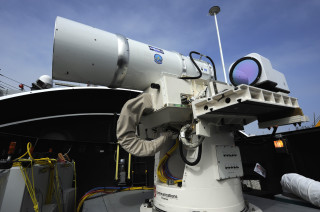
The Navy will deploy a laser weapon designed to counter small boats and unmanned aerial vehicles to the Middle East in 2014, chief of Naval Research Rear Adm. Matthew Klunder and Naval Sea Systems Command chief engineer Rear Adm. Tom Eccles said in a joint Monday briefing at the Navy League Sea Air Space Exposition 2013 at National Harbor, Md.
The solid-state Laser Weapon System (LaWS) will be deployed onboard the USS Ponce in 2014, a former amphibious warship that has been reassigned to serve as an Afloat Forward Staging Base in U.S. Central Command.
“What was the need? To counter UAVs and fast boats,” Klunder said. “The area we’re going to test this in is a very intensive maritime region of the world. Lots of commerce, lots of ships.”
Described by Eccles as the equivalent of a heavy industrial laser, LaWS will integrate into existing targeting systems onboard the AFSB and potentially any other ship in the fleet.
The concept would have the laser be able to have several different power settings: From a so-called dazzle effect to confuse sensors to a lethal ability that would be able to splash an unmanned aerial vehicle to disable a small boat.
Part of the selling point would be to integrate LaWS with existing ship systems.
“It uses the exact same weapon systems that exist today,” Klunder said.
“The existing naval ships we have today can use these weapon systems.”
Eccles and Klunder did not elaborate on the strength, range or power consumption of LaWS only to say the range was “tactically significant,” the system and would not draw excessive power from ship systems.
During a test, last year aboard the USS Dewey (DDG-105), LaWS was combined with a commercial power system and not integrated into the ships power grid.
Operating out of U.S. 5th Fleet headquarters in Bahrain, Ponce spends most of its operational time in the Persian Gulf, among the most crowded maritime environments in the world.
Iranian aircraft, ships and boats typically harass U.S. ships in the region but both Eccles and Klunder did not say those ships, boats and were the targets of the program.
Iran has developed unmanned aerial vehicles since the 1980s and has commonly operated those systems in the Persian Gulf. The Iranian Navy also has a large number of small and fast surface ships it employs in the Persian Gulf.
Earlier on Monday, Adm. Jonathan Greenert Chief of Naval Operations, voiced support for the LaWS test deployment.
“I want to get it (laser weapons) out in the environment right now,” he said.





